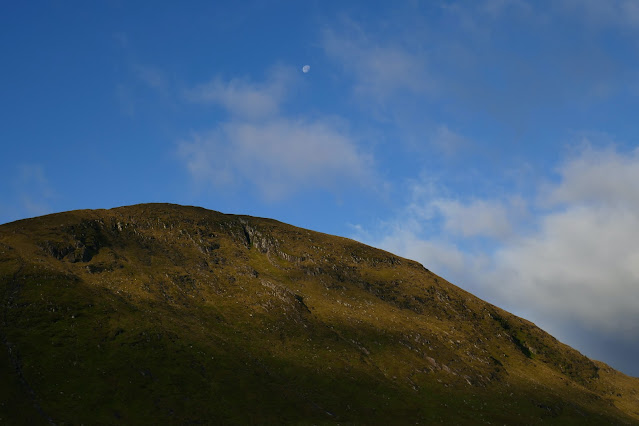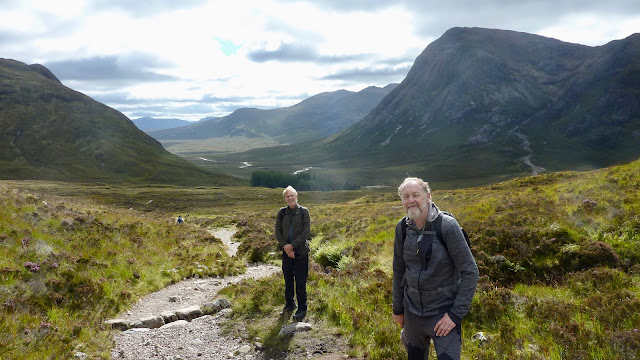 |
| A hole fit for hobbits |
 |
| A waning gibbous moon |
The waning gibbous moon was following the path of last night’s sun to hang as a silvery ornament above Glen Etive. After a few moments appreciation of the vast panoramic views I quietly let myself back into our hobbit hole but my dawn wanderings had woken both Chris and Jerome who immediately needed to head off to the toilet block (we’re all men of a certain age). We were grateful to be so close, the line of hobbit huts went on for forty or fifty yards and although there were showers and the drying cupboard at the other end of the site, all the toilets were down our end.
The resort itself is as old as we are, as the first ski lift opened in 1956. Back then it was known as White Corries and it is famous for hanging onto snow much later in the season than other ski-ing areas in the UK. It’s not a big resort but it is popular and the wooden lodges that we’re staying in are in use all year round.
We made our way to the cafe as early as possible but we were not the first. As we neared the business end of the queue, various breakfast items started to run out leaving a Hobson’s choice of the less popular wares. Jerome pounced on the last of the sausages and Chris and I were left with the Lorne sausage that was being defiantly proffered by the serving assistant as merely a different shape of sausage. Which it is … normally. One glance told me that this was a much more robust version. Rather than resembling a product of Lorne, Chris said it had more of the characteristics of Kirkcaldy and its famous linoleum factory, it being tough enough to double as this durable flooring material. Certainly a Stanley knife would have been handy to cut it up.
The Scottish breakfast that we’d been offered in all the places we stayed was not in any way traditional. In just one place was there porridge - a carve yourself version. Other items of typical Scottish fare, kippers for example, were never on the menu. Almost everywhere had fried haggis,* black pudding, bacon and Lorne sausage along with a potato cake or slice, as it was termed - which always looked as though instead of being fried, that it had been lightly poached in oil until a peculiar translucent saturation had been reached. Every place offered eggs in various forms and a vegetable component, which typically included a variety of baked beans, tomatoes and mushrooms depending on the facilities and supplies available. This would be completed by a round of toast which would arrive at a random moment in the meal.
(* Don’t get me started about frying haggis.)
 |
| The pass of Glencoe |
I picked up my clothes, which were significantly less smelly, from the drying cupboard and we prepared to leave. We were headed to Kinlochleven this evening. At about eleven miles, it was not a long walk but this stretch is famous for the Devil’s Staircase, the route up and out of Glencoe. Despite this notorious climb there is only twelve hundred feet of elevation gain.
.jpeg) |
| The Kingshouse Hotel (foreground) and Glencoe mountain resort (background) |
We retraced our steps from yesterday down to the Kingshouse Hotel. The inn was open so we rested at the picnic tables in the sunshine with a coffee, watching as some of the hotel guests gathered in sheepish groups with extremely fit-looking mountain guides. I can only surmise that the hotel guests have been assured that this level of protection was necessary to safely access the wild mountainside. Of course, a guide would lead, show and explain. However, this morning the weather was set fair and the guides were well aware that these paths really could not be more clearly marked.
.jpeg) |
| The Herdsman of Etive |
The path runs roughly parallel to the road in the valley bottom. To the south was Glen Etive. The OS map has Buachaile Etive Mór as the name of the ridge and Stob Dearg as the mountain that faces us today. For those of us who are not fluent in Gaelic it may be safer to refer to the mountain as ‘the Herdsman of Etive’ as there is a certain amount of heated argument about its correct pronunciation.
If there was ever a pageant to crown the most beautiful mountain in Scotland I am sure that the Herdsman would one of the contenders. It’s right up there with Suilven as one of the country’s most recognisable mountains, more so than Ben Nevis which although it is a huge massif, most of the time it has its head and shoulders in the clouds. The Herdsman is often claimed to be the most photographed mountain in Scotland, which I would suggest is most likely because of its position beside the A82.
In the shadow of the Herdsman a small road turns off the main road and heads down Glen Etive. These days this road is often called the ‘Skyfall’ road as it was one of the dramatic locations used in the 2012 Bond film. It has become a popular route, despite being a single track road that terminates at Loch Etive after twelve miles.
.JPG) |
| South west along the Lairig Gartain |
We followed the old military road until we reached the turn for the pass between Stob Mhic Martuin and Beinn Bheag. Beside which was a large car park littered with coffee and catering vans. Many people were stopping to take in the view, others to walk or climb. The path up and along the ridge of Buachaile Etive Mór starts from here but most of the day trippers have been drawn by the Devil’s Staircase.
Since the fourteenth century this has been an old drover's road, used to shepherd cattle from Skye to markets in the lowlands. After the Jacobite rebellions the roads were upgraded, so that the military could more easily access the Highlands. The name 'Devil's Staircase' was coined by the soldiers who had to haul cannon and munitions up and over the pass. One hundred years later workers on the Blackwater reservoir used the pass, as it was the nearest route to a public house for a drink which was back at Kingshouse. On their return journey a few unfortunate souls lost their footing and died, leading their colleagues to remark that 'the devil had claimed his own.'
 |
| Half way up |
From the road turning, the journey to the head of the pass is 1.1 miles with about 900 feet of ascent. I would like to tell you that it was an arduous climb, that every step was fraught with danger ...
.jpeg) |
| Fraught with danger |
... but that would be a lie. Maybe when the conditions are less clement it could be hard work, fighting against a blustery wind with squally showers but we faced none of these hardships and reached the top in forty five minutes.



Comments
Post a Comment
Leave a comment here